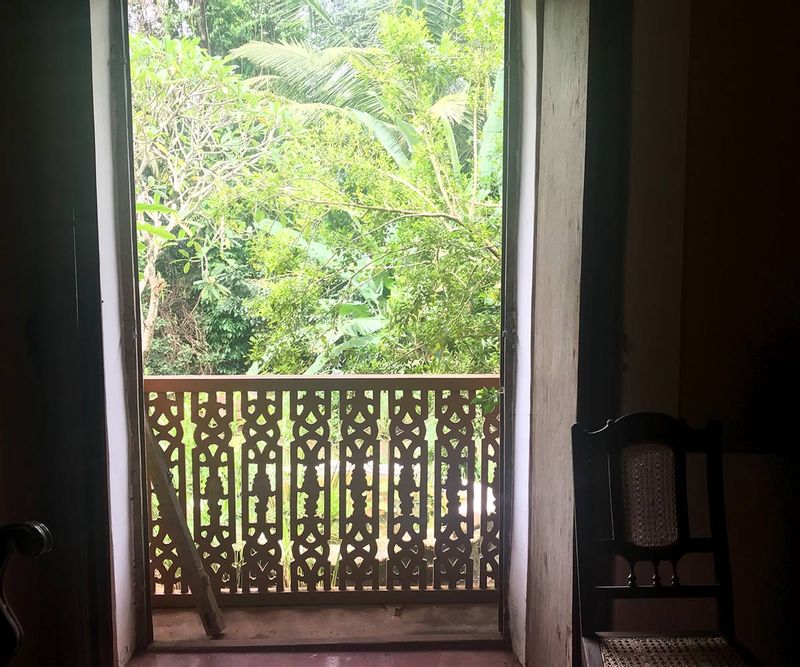The yellow and white paint on the walls of the palatial house with a tiled roof, looked fresh and yet you could tell that the house held secrets and stories from a different time. The gardens had turned the brightest shade of green post the morning showers. A flight of stairs led us to the porch of The Palácio do Deão in Quepem, 14 km from Margao, Goa. Waiting for us there, was Ruben Vasco da Gama, the current owner, and our host for the day. When our initial awestruck feelings settled a bit, we were taken by the thought of what a massive undertaking it must be to maintain a home like this. As we strolled through the vast hallways and rooms of the house, Ruben told us about its interesting history.
Preservation of stories

The house was built in 1787, by a Portuguese nobleman named Jose Paulo, who was the Dean of the Church and the founder of Quepem town. He arrived in Goa in 1779 along with the Archbishop, Dom Frei de Santa Catarina. He constructed this spacious house spread over 11,000 sq ft which he described, at the time, as a ‘farm house’. In 1829, he presented the Palácio do Deão to the Viceroys of India-Portuguese, for their recreation. When Jose Paulo passed away, after spending 55 years in Goa, the Palácio was occupied by a cleric. Around 1989, the house was given to some nuns to be run as a home for destitute women. It is said that they had a hard time keeping up with the maintenance of the house and, they too abandoned the house. Finally, it was decided to privatise it and open it up for public viewing.
That’s when Ruben and his wife Celia Vasco da Gama bought it and took over the mammoth task of its restoration, which took three years to complete and, in Rubens's words, is “still work in progress.” While Ruben is an engineer, he has been working in the field of restoration since 1992. Celia, a microbiologist, also took to cooking and spent a lot of time researching old Portuguese recipes. “We wanted the experience to be complete and give people a reason to travel all the way to come and see the house. Preserving heritage is important to us and so is giving back to the local community,” Ruben tells us.
The architecture is an interesting blend of Hindu and Portuguese styles. “Traditionally the altar was always inside the house. In this house, however, you can see a Hindu influence, where just like the temple space in a Hindu house, the altar is right in the front area of the house,” Ruben explains. The house faces the Church that Jose Paulo built and is on the banks of the Kushavati River. The immaculately maintained gardens is home to a pond, balustrades (rows of small columns topped by a rail), and stone ornaments. There’s a library, with an interesting collection of books on Goan history, arts and crafts, and theology. There’s also a lovely open-sided gallery with a view of the river, where our meals are served.
A Goan food story

While the weather was responsible for making us hungry, Ruben gave us a disclaimer about this being a simple home-cooked meal and told us that it may not be ‘hotel like’. Some of the vegetables came straight from Ruben’s farm. The organic red rice is grown by them too as are the jamuns for the Jamun-fenny cocktail.

The starters arrived first. Rissois de Camarão, a Portuguese dish where half-moon-shaped savoury fried snacks are stuffed with shrimp. Crisp and light, the rissois were polished off almost as soon as they reached the table. The toast with brinjal pâté was unusual and delicious. Our favourite though was the stuffed crab, flavourful and cooked to perfection.
The main course kept arriving relentlessly, one after the other. There was Ambadyachi Uddamethi- a sweet and sour, summery raw mongo curry, Bendi Curry (ladyfinger), Gosadi Baji (ridged gourd), French bean bhaji, the melt-in-the mouth Tamuso (red snapper) in garlic, a very Goan Prawns Chilli Fry and a savoury Pumpkin Pie. For dessert there was sliced pineapple, caramelized and soaked in alcohol. “Many of these recipes come from my mother and Ruben’s mother. Family and friends have contributed over the years as well. I try and use available ingredients, and most of the dishes require only a few of these, but the taste comes from the freshness of the ingredients and the slow cooking process,” Celia tells us.

Don’t miss out on this delicious slice of history when you are in Goa next.




